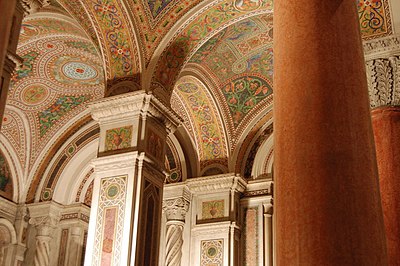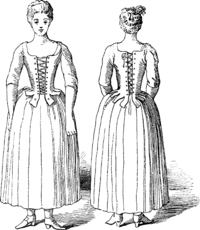Design: Difference between revisions
added homonym to first sentence |
add seven elements of concrete design from interior design article and specify abstract vs. concrete |
||
| Line 1: | Line 1: | ||
[[Image:All_Saints_Chapel--L.C._Tiffany.JPG|thumb|400px|right|All Saints Chapel in the Cathedral Basilica of St. Louis by Louis Comfort Tiffany. The building structure and decorations are both examples of design.]] |
[[Image:All_Saints_Chapel--L.C._Tiffany.JPG|thumb|400px|right|All Saints Chapel in the Cathedral Basilica of St. Louis by Louis Comfort Tiffany. The building structure and decorations are both examples of design.]] |
||
'''Design''' |
'''Design''' is the manipulation of elements to create a functional and/or pleasing product. It is a [[homonym]], used as both a [[verb]] and a [[noun]]. "Design" as a verb refers to the process of planning. As a noun, "design" is used for the final plan or final product. The process of designing often includes [[research]] and [[model (physical)|modeling]]. |
||
The word is most often used in relation to concrete products, such as in the [[applied art]]s, [[engineering]], and [[architecture]]. In designing concrete items, seven elements are commonly recognized. These are [[form]], [[mass]], [[shape]], [[line]], [[color]], [[texture]] and [[pattern]]. |
|||
Designing normally requires considering [[aesthetic]], [[functional]], and many other aspects of an object, which usually requires considerable [[research]], [[thought]], [[model (physical)|modeling]], interactive adjustment, and re-design. |
|||
| ⚫ | |||
Design as a [[Process (general)|process]] can take many forms depending on the object being designed and the individual or individuals participating. |
|||
| ⚫ | |||
[[Image:Crystal_128_kivio.png|right]] |
[[Image:Crystal_128_kivio.png|right]] |
||
Revision as of 23:33, 28 November 2006

Design is the manipulation of elements to create a functional and/or pleasing product. It is a homonym, used as both a verb and a noun. "Design" as a verb refers to the process of planning. As a noun, "design" is used for the final plan or final product. The process of designing often includes research and modeling.
The word is most often used in relation to concrete products, such as in the applied arts, engineering, and architecture. In designing concrete items, seven elements are commonly recognized. These are form, mass, shape, line, color, texture and pattern.
In abstract applications, such as philosophy and theology, the noun "design" refers to pattern, or to purpose. Design is thus contrasted with purposelessness, randomness, or lack of complexity. The philosophical study of abstract design is teleology.

A Definition of the Design Process


According to video game developer Dino Dini in a talk given at the 2005 Game Design and Technology Workshop held by Liverpool JM Univeristy, design underpins every form of creation from objects such as chairs to the way we plan and execute our lives. For this reason it is useful to seek out some common structure that can be applied to any kind of design, whether this be for video games, consumer products or one's own personal life.
For such an important concept, the question "What is Design?" appears to yield answers with limited usefulness. Dino Dini states that the design process can be defined as "The management of constraints". He identifies two kinds of constraint, negotiable and non-negotiable. The first step in the design process is the identification, classification and selection of constraints. The process of design then proceeds from here by manipulating design variables so as to satisfy the non-negotiable constraints and optimising those which are negotiable. It is possible for a set of non-negotiable constraints to be in conflict resulting in a design with no solution; in this case the non-negotiable constraints must be revised. For example, take the design of a chair. A chair must support a certain weight to be useful, and this is a non-negotiable constraint. The cost of producing the chair might be another. The choice of materials and the aesthetic qualities of the chair might be negotiable.
Dino Dini theorises that poor designs occur as a result of mismanaged constraints, something he claims can be seen in the way the video game industry makes "Must be Fun" a negotiable constraint where he believes it should be non-negotiable.
It should be pointed out that "The Management of Constraints" should not be confused with Constraint Management which is a term used in connection with Theory of Constraints.

In the UK, the magazine Design week is devoted to design and the industries design encompasses.
Design versus Production
The relationship between design and production is one of planning and executing. In theory, the plan should anticipate and compensate for potential problems in the execution process. Design involves problem-solving and creativity. In contrast, production involves a routine or pre-planned process. A design may also be a mere plan that does not include a production or an engineering process, although a working knowledge of such processes is usually expected of designers. In some cases, it may be unnecessary and/or impractical to expect a designer with a broad multidisciplinary knowledge required for such designs to also have a detailed knowledge of how to produce the product.
Design and production are intertwined in many creative professional careers, meaning problem-solving is part of execution and the reverse. As the cost of rearrangement increases, the need for separating design from production increases as well. For example, a high-budget project, like a skyscraper, requires separating (design) architecture from (production) construction. A Low-budget project, like a locally printed office party invitation flyer, can be rearranged and printed dozens of times at the low cost of a few sheets of paper, a few drops of ink, and less than one hour's pay of a desktop publisher.
This is not to say that production never involves problem-solving or creativity, nor design always involves creativity. Designs are rarely perfect and are sometimes repetitive. The imperfection of a design may task a production position (e.g. production artist, construction worker) with utilizing creativity or problem-solving skills to compensate for what was overlooked in the design process. Likewise, a design may be a simple repetition (copy) of a known preexisting solution, requiring minimal, if any, creativity or problem-solving skills from the designer.
See also
Footnotes
- ^ Concerns the existence and construction of mathematical set systems that have specified numerical properties.
- ^ Drafting and other forms of modelling.
- ^ A creationist theory.
- ^ Examines the role of embedded behaviour in human environments.
- ^ Actively involving users in the design process.
- ^ Includes economic, environmental and political issues.
